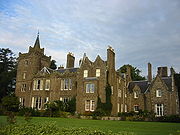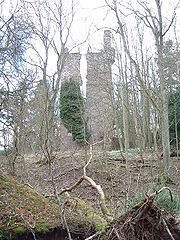
Finavon Castle
Encyclopedia

River South Esk
The South Esk is a river in Angus, Scotland. It goes past Brechin and enters the North Sea at Montrose Basin. It was noted in the 19th century.-References:...
, about a quarter of a mile south of Milton of Finavon
Milton of Finavon
Milton of Finavon is a hamlet in Angus, Scotland that lies adjacent to the A90 road on its southern side by the River South Esk. It is approximately 5 miles north-east of Forfar.A quarter of a mile to the south lies Finavon Castle....
village and five miles to the north-east of Forfar
Forfar
Forfar is a parish, town and former royal burgh of approximately 13,500 people in Angus, located in the East Central Lowlands of Scotland. Forfar is the county town of Angus, which was officially known as Forfarshire from the 18th century until 1929, when the ancient name was reinstated, and...
in Angus
Angus
Angus is one of the 32 local government council areas of Scotland, a registration county and a lieutenancy area. The council area borders Aberdeenshire, Perth and Kinross and Dundee City...
, Scotland
Scotland
Scotland is a country that is part of the United Kingdom. Occupying the northern third of the island of Great Britain, it shares a border with England to the south and is bounded by the North Sea to the east, the Atlantic Ocean to the north and west, and the North Channel and Irish Sea to the...
. The name is applied both to a ruined 17th century castle
Castle
A castle is a type of fortified structure built in Europe and the Middle East during the Middle Ages by European nobility. Scholars debate the scope of the word castle, but usually consider it to be the private fortified residence of a lord or noble...
, as well as the 19th century mansion house 130m to the west.
History
The estate was the property of the LindsayClan Lindsay
-Origins of the Clan:There is currently no known proven path pertaining to the origin of the Clan Lindsay. However, several possible theories have been advanced over the years. First is the theory proposed in 1769 by biographer/historian, Richard Rolt, in which he claimed that the Lindsays were...
Earls of Crawford
Earl of Crawford
The title Earl of Crawford is one of the most ancient extant titles in Great Britain, having been created in the Peerage of Scotland for Sir David Lindsay in 1398. It is the premier earldom recorded on the Union Roll.The title has a very complex history...
from 1375, who built the now-ruined castle. David Lindsay, 10th Earl of Crawford, married Margaret, the daughter of Cardinal David Beaton
David Beaton
The Most Rev. Dr. David Cardinal Beaton was Archbishop of St Andrews and the last Scottish Cardinal prior to the Reformation.-Career:...
, at Finavon in 1546.
Extravagance ruined the Crawford fortunes, and in 1625 the barony of Finavon was disposed of by a forced sale to Alexander Lindsay, 2nd Lord Spynie
Lord Spynie
The Lordship of Parliament of Spynie was created once in the Peerage of Scotland on 4 November 1590 for Sir Alexander Lindsay. On the death of the third lord in 1671, the lordship became dormant.-Lords Spynie :...
. It passed through the Carnegie family
Carnegie of Finhaven
Carnegie of Finhaven is famous for his trial for the killing of Charles Lyon, 6th Earl of Strathmore and Kinghorne which resulted in the not guilty verdict becoming a recognised part of Scots law and establishment the right of Scots juries to judge the whole case and not just the facts, a right...
, the Gordon Earls of Aboyne
Earl of Aboyne
Earl of Aboyne is a title in the Peerage of Scotland, borne in the Gordon family ....
and the Gardynes
Clan Gardyne
Clan Gardyne or Clan Garden is an armigerous lowland Scottish Clan from Angus.The chiefly family of Garden or Gardyne of that Ilk are a very ancient family, who were proprietors in Angus from a remote period, and are first recorded in the locality of the Kirkdon of Angus in 1008 when they are...
.
In 1843 the Castle was bought by Thomas Gardyne of Middleton
Thomas Gardyne
Thomas Gardyne of Middleton and Finavon was a Scottish laird and founder of the village of Friockheim in Angus, Scotland.-Family:He was the third son of James Gardyne of Lawton and Middleton and Mary Wallace, daughter of Thomas Wallace a merchant, ship-owner and Provost of Arbroath.-Friockheim:A...
. Through an 18th-century marriage he came of the old Lindsay stock. His descendant, Lieutenant-Colonel Charles Greenhill Gardyne died in 1953, leaving the estate to a daughter, Mrs Susan Mazur.
The castle

The house
The house is a Scottish baronial styleScottish baronial style
The Scottish Baronial style is part of the Gothic Revival architecture style, using stylistic elements and forms from castles, tower houses and mansions of the Gothic architecture period in Scotland, such as Craigievar Castle and Newark Castle, Port Glasgow. The revival style was popular from the...
mansion
Mansion
A mansion is a very large dwelling house. U.S. real estate brokers define a mansion as a dwelling of over . A traditional European mansion was defined as a house which contained a ballroom and tens of bedrooms...
built in 1865 for the then laird
Laird
A Laird is a member of the gentry and is a heritable title in Scotland. In the non-peerage table of precedence, a Laird ranks below a Baron and above an Esquire.-Etymology:...
, David Greenhill Gardyne, by Messrs Carver and Symon of Arbroath
Arbroath
Arbroath or Aberbrothock is a former royal burgh and the largest town in the council area of Angus in Scotland, and has a population of 22,785...
. Part of the castle is now let as holiday accommodation.
Other nearby features
The nearby Finavon Doocot is Scotland's largest doocotDovecote
A dovecote or dovecot is a structure intended to house pigeons or doves. Dovecotes may be square or circular free-standing structures or built into the end of a house or barn. They generally contain pigeonholes for the birds to nest. Pigeons and doves were an important food source historically in...
, with 2400 nesting boxes. It is believed to have been built for the Earl of Crawford in the 16th Century and is now maintained by the National Trust for Scotland
National Trust for Scotland
The National Trust for Scotland for Places of Historic Interest or Natural Beauty, commonly known as the National Trust for Scotland describes itself as the conservation charity that protects and promotes Scotland's natural and cultural heritage for present and future generations to...
.
On Finavon Hill, above the Castle there is a vitrified Iron Age
Iron Age
The Iron Age is the archaeological period generally occurring after the Bronze Age, marked by the prevalent use of iron. The early period of the age is characterized by the widespread use of iron or steel. The adoption of such material coincided with other changes in society, including differing...
hillfort dating from the mid-1st millennium BC.
The Finavon Castle beat on the River South Esk provides salmon and seatrout fly fishing.

